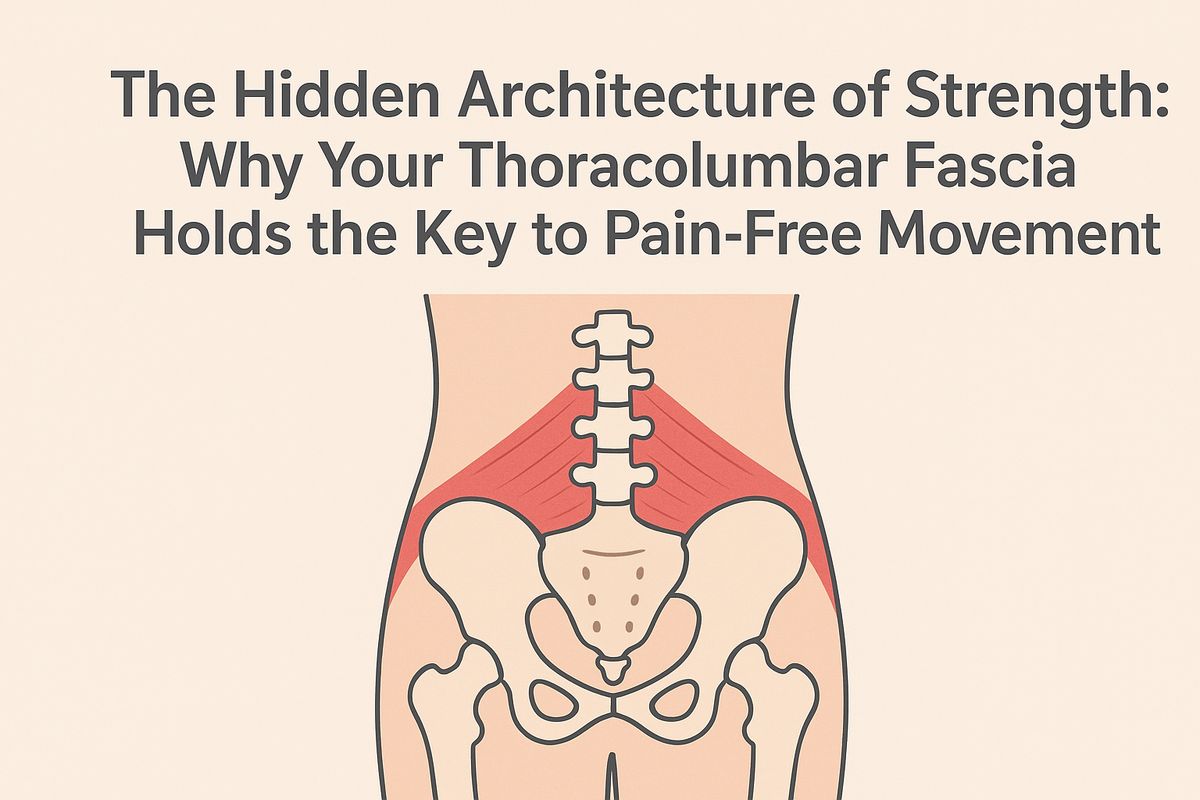Listen — if you have a spine and ever plan to move without pain, this message may be the most important thing you read this year.
Possibly in your entire life.
I’m going to tell you about a structure in your body so vital, so fundamentally powerful, that it dictates how strong you are, how fast you move, and why this autumn your lower back feels like concrete when you get out of bed. 🍂
And here’s the kicker: it’s NOT a muscle. It’s not a bone. And your doctor probably doesn’t even realise it.
If you’re sick of endlessly “stretching your hamstrings” yet still feel stiff, weak, and fragile… LISTEN CLOSELY.
What I’m about to reveal is the hidden architecture of human strength.
We call it the Kinetic Node.
But its real name? The Thoracolumbar Fascia (TLF).
Forget everything you thought you knew about back pain. Grab a coffee ☕️ and let’s dive into the secrets of your inner super-suit.
“The Smart Corset” You Never Knew You Had
The TLF isn’t just a passive wrapping. It’s a dense, multi-layered diamond of high-tech connective tissue in your lower back. Think of it as your body’s natural corset — but far smarter.
It’s the ultimate connector. 🔄
The TLF is Grand Central Station for your most powerful muscles. Your glutes, lats (“wings”), and deep core muscles plug directly into it.
It literally ties your arms to your legs.
🤯 The Shocking Truth (and Why You’re Weak)
Here’s where it gets fascinating. The TLF doesn’t just hold you together — it actively makes you stronger.
How? Through the so-called Hydraulic Amplifier Effect.
The TLF wraps tightly around your deep spinal muscles. When these muscles contract, they try to bulge outwards. But the stiff fascia RESISTS that bulge. This generates massive internal pressure.
💥 That pressure stabilises your spine like concrete — and can increase your effective strength by up to 30 per cent.
Yes, thirty per cent!
Just think: a weak or “sticky” TLF means you’re leaving 30% of your potential strength unused.
But that’s not all.
The TLF is also one of your body’s biggest sensory organs. It has up to three times more nerve endings than the surrounding muscles.
🚨 Paradigm shift: much of what you call “muscle pain” is actually fascia pain. It’s your fascia screaming at you.
The “Sticky Fascia” Problem (Why You Feel 80 Years Old)
So how does this amazing structure cause so much trouble?
In a healthy TLF, layers glide smoothly, lubricated by Hyaluronan (yes, the same stuff in expensive face serums!).
But modern life — sitting, stress, inflammation, dehydration — alters the chemistry of this lubricant.
It thickens. Gets sticky. Like honey. 🍯
This is called fascia densification. The layers GLUE together.
When your fascia can’t glide, you can’t move. Your brain perceives this restriction as a threat. It tightens surrounding muscles — leading to stiffness, pain, and that “I just aged 50 years overnight” feeling when you wake up.
Hidden Links: Stress, Gut, and Glutes
Your TLF is a mirror of your systemic health. Everything is connected.
🧠 Stress link: The TLF contains tiny contractile cells (myofibroblasts). When you’re stressed, they literally CONTRACT — independent of your muscles. Chronic stress = chronically tight fascia.
🥦 The gut–fascia axis: This is HUGE. Gut inflammation directly fuels fibrosis (hardening) and sensitisation of your TLF. Back pain often begins in the gut.
🍑 The “dead glute” myth: You’ve heard sitting makes your glutes “forget” how to work. That’s not quite true. Painful, sticky fascia sends DANGER signals to the brain. The brain, trying to protect you, “turns down the volume” on your most powerful partner muscle — the glutes.
💡 Your Fascia Action Plan (SAVE THIS!)
The beauty of fascia? It responds. It’s alive. You can change it.
You don’t need fancy gadgets. You need the right inputs.
💧 1. Hydrate like it’s your job: Fascia NEEDS water to glide. Dehydration = sticky fascia.
🌀 2. Move in ALL directions (3 rules): Fascia hates stillness. It craves variety.
- Twisting: gentle rotations
- Side bends: lateral flexion
- Arching/Rounding: Cat-Cow type movements
🏋️♀️ 3. Master the hip hinge: Stop bending from your back! Learning to hinge at the hips (like in a deadlift) is critical. It loads the fascia correctly.
🌬️ 4. Breathe with your diaphragm: Deep belly breathing massages your core from within and activates your calming nervous system. Shallow chest breathing = tense fascia.
🏃♀️ 5. Use elasticity (bounce!): Fascia thrives on elastic recoil. Gentle bouncing, hopping, or dynamic stretching (instead of long static holds) trains your fascia’s “catapult” system.
The Thoracolumbar Fascia is the hidden architecture of your movement. The kinetic node.
Understanding how it works gives you the power to break free from chronic stiffness and unlock levels of strength and resilience you didn’t know you had.
Take care of your fascia — and it will take care of you. ✨
👇 What’s your experience? 👇
Did you know fascia could do this? What’s the ONE thing that makes your back feel the stiffest? Share below! 👇
